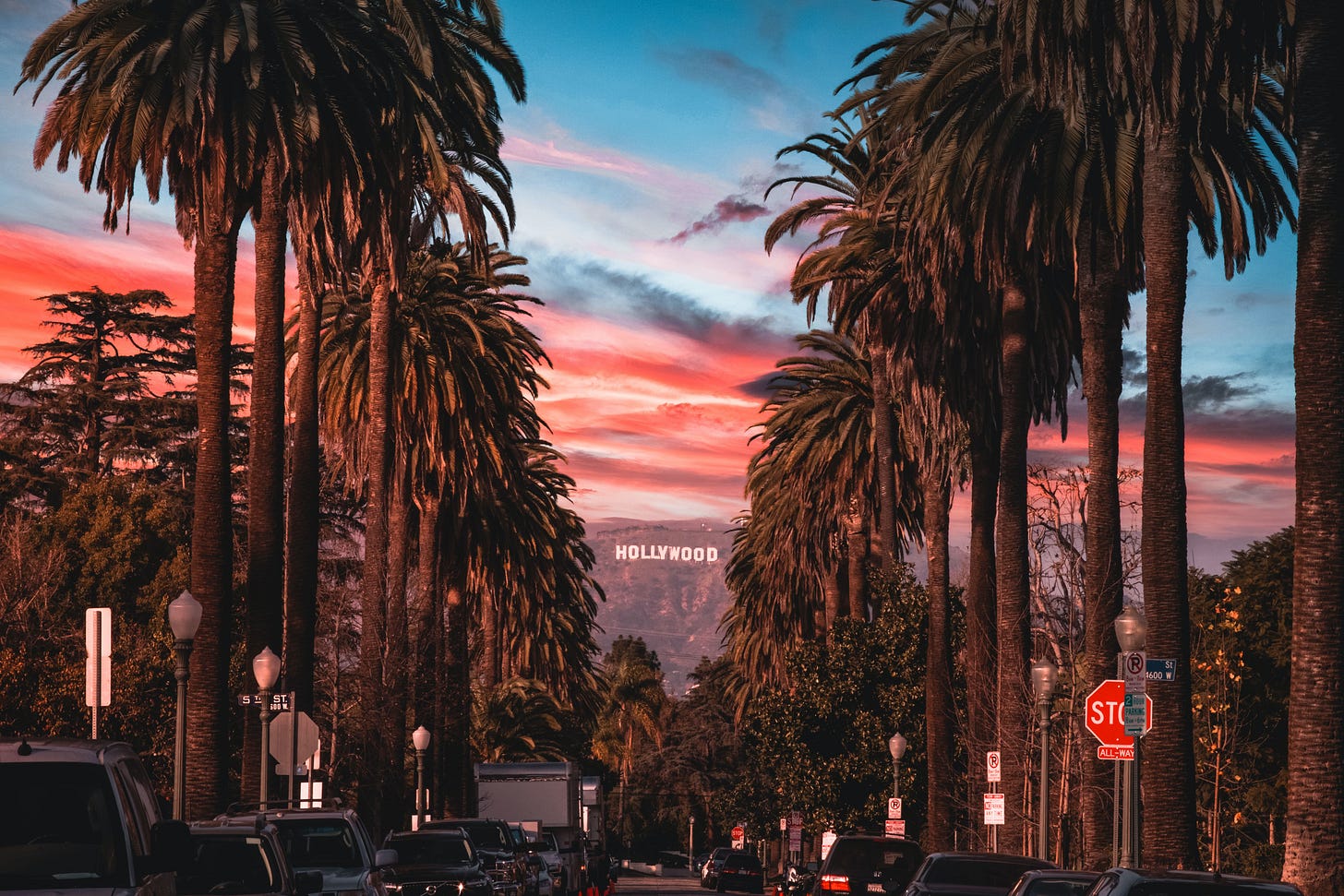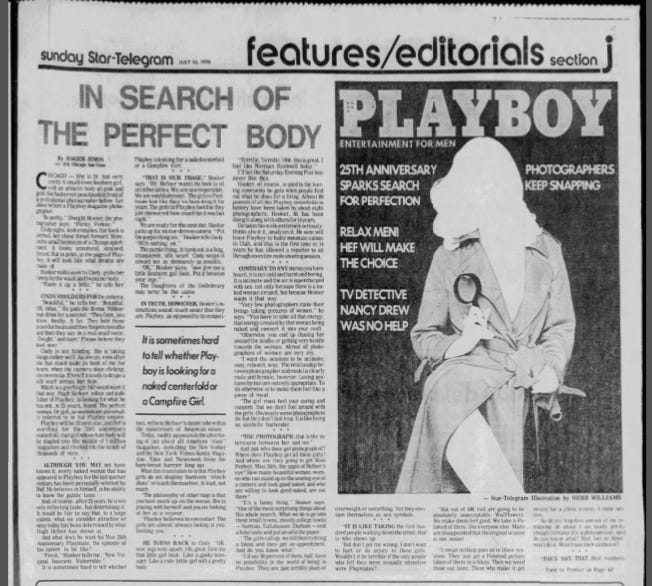This is a serialized longform essay about two pivotal issues of Playboy magazine in the late 1970s. Click here to read the introduction to the series.
Everything about the Silver Anniversary celebration and the media events surrounding it showed how deeply Playboy was entrenched in the mainstream. The Great Playmate Hunt that stretched out for months had Playboy representatives traveling to thirty cities, targeting towns with major universities such as Frankfort, Kentucky and San Diego, California and interviewing and photographing nearly four thousand young women.
That search could not have been more of an acceptable, cultural event, covered by the media in news articles such as, “Search for Ideal Nude Finds Many Are Willing” and “Focus on Coeds as Hefner Seeks Silver Centerfold.” In May 1978, the supplement to virtually every Sunday paper, Parade Magazine, featured David Chan, a photographer who’d been working at the magazine for fourteen years at the time, in a write-up simply called “Coed Models.” The Parade article shared the same page as a display for Bilco Basement doors, the watertight kind that open from the backyard so lawn furniture can be easily stored in the winter. The word “coed” kept coming up. College girls that Mr. Chan described as no longer fearful of what their family and friends might say. According to Mr. Chan, these were young women of a generation that “now took nudity in stride.” Parade detailed news of the 25th Anniversary issue that would soon be published with Playboy offering $25,000 to the centerfold model. The Great Playmate Hunt could not have been set out more clearly for all of America.
David Chan was an unassuming presence, nothing flashy in the least, and he and his fellow photographers seemed to blend in everywhere they went. He appeared on the TV show, Evening Magazine, where he talked about the girl-next-door Playboy hoped to find for the Silver Anniversary Playmate.
The search had Playboy splashed across suburban Sunday papers. A feature article from the Chicago Sun Times, and syndicated in places like the Fort Worth Star-Telegram with the title, “In Search of the Perfect Body,” began with the description of a nervous 24-year-old from South Carolina and her audition in the form of a nude photo session with celebrated photographer, Dwight Hooker. The nearly quarter-page graphic accompanying the article was essentially a mockup of a Playboy magazine cover with the outline of a woman wearing only a strategically arranged trench coat and holding a magnifying glass, highlighting the full-throttle search for the 25th Anniversary centerfold. The article being on the first page of the paper’s J-Section would have been readily seen by any ten-year old leafing through the paper to find the comics or TV listings or an item to be clipped for a weekly current events assignment.
When the search finally reached an end with Playboy’s selection of Candy Loving as the contest winner and the Silver Anniversary issue released, there were parties in Chicago and Los Angeles. Australia’s oldest newspaper, The Sydney Morning Herald, detailed the celebration in New York, held at “Central Park’s glittering Tavern on the Green.” George Plimpton (Harvard alum, close friend of Robert F. Kennedy, and founder of The Paris Review) served as the master of ceremonies for the night. That lavish and jubilant event made its way into the final pages of Gay Talese’s 1980 best-seller, Thy Neighbor’s Wife, an exploration of sexuality in America post World War II (a book so immensely popular, it was optioned for film rights at $2.5 million, the largest amount ever paid at the time.) All those many threads. Playboy weaving its way through mainstream culture, in good company with those at the very top in the realms of art, literature, politics and journalism. Per the Fort Worth, Star-Telegram, Hugh Hefner received “head-of-state treatment” at another of Playboy’s Silver Anniversary parties, this one hosted at the Washington Press Club. As described on the club’s website: “Through its doors have come presidents, premiers, kings and queens, Cabinet secretaries, senators and House members, movie stars and sports heroes, titans of business and finance — a who’s who of the 20th and 21st centuries…”
The media attention and planned events continued well into 1979, crossing back into pop culture with an ABC TV special airing on the first Monday night in May. The prime-time feature was hosted by James Caan and Tony Curtis with footage of Ray Bradbury, Bing Crosby and Carl Sandburg and many many others. The hour-long program focused heavily on both Hefner and Playboy’s social activism, their hard work alongside every one of the major upheavals the 1960s and 70s were known for. Both Hugh Hefner and Playboy had championed the protests against Vietnam, the civil rights movement, the sexual revolution, the women’s movement and the counterculture in general. There was footage of a gay pride parade and the NAACP Image Award given to Mr. Hefner in 1976. The video montages (narrated by George Plimpton in his distinctly patrician voice) ended with Playboy’s support of the right to abortion and a clip of Gloria Steinem stating, quite famously, that “if men could be pregnant, abortion would be a sacrament.” Though she was not a guest, one woman in Akron, Ohio was mistaken and wrote a letter to her newspaper questioning why a feminist as prominent as Ms. Steinem would appear in the Playboy special.
Later in the year, buoyed by the popularity of the Silver Anniversary programming, “Playboy’s Roller Disco and Pajama Party” aired, also on Prime-Time television. The title says as much as you really need to know; musical performances by The Village People and an excruciating guest appearance by Wayland Flowers, a puppeteer, and Madame, his brash and opinionated sidekick. The real marker here, after all, is Playboy having two TV specials in one year, both featuring household names ranging from mainstream pop culture (Richard Dawson, host of the 70s break-out hit, Family Feud) to national icons like Bing Crosby.
Maybe fittingly, the celebration of Playboy’s 25 years in American life was spearheaded by a young woman only slightly older than the magazine. Christie Hefner. A Phi Beta Kappa graduate of Brandeis University, she was already a self-described feminist serving on the National Women’s Caucus Advisory Board. One of the many in-depth features of her at that time began with a description of the hand-written note in her office thanking both her and Playboy for their support of the Equal Rights Amendment. The note had been sent by Jean Stapleton, the popular actress and vocal supporter of the ERA. Along with the Great Playmate Hunt and the parties, Ms. Hefner initiated the Hugh M. Hefner First Amendment Award to mark the magazine’s 25th Anniversary. The first year judges were Tom Bradley, Mayor of Los Angeles; Jules Feiffer, playwright; Fay Kanin, president of The Academy of Arts and Sciences; Victor Navasky, editor of The Nation; and Tom Wicker, columnist and associate editor of The New York Times.
Hugh Hefner’s daughter was soon to “become Playboy’s mouthpiece, supporting First Amendment freedoms, women’s rights and decriminalization of marijuana.” She said things like, Playboy “champion[ed] women’s rights before there was such a thing,” and that there was nothing demeaning about “presenting nudity and sexuality in a positive way.” Curiously, similar comments on both sexual liberation and the women’s movement had been made by Playmates, and these were routinely ignored, but the press deferred to Ms. Hefner who by 1982, would take over as Playboy’s president and steer the company out of financial difficulties. Presaging her rise was her deft handling of the Silver Anniversary celebration, her first major assignment for the company.
By 1979, Playboy was a moving target for feminists with Christie Hefner rising in the executive suite; the young feminist on her way to running the magazine. Then there was the project itself, the Silver Anniversary celebration, with the parties and TV specials and Great Playmate Hunt, all of it costing $1.5 million and amassing huge media coverage. A joyful reminder that Playboy had become fairly mainstream. The magazine was not only a presence, but a virtual tattoo on American culture. John E. Reinhardt, head of the U.S. government’s International Communication Agency, said as much when interviewed at the Washington Press Club reception. “Mr. Hefner is part of the contemporary American scene. So is his magazine. Those who are interested in contemporary America would be interested in his views, whether or not they subscribe to them.”
My first pass at research showed that while the women’s movement might have been irked by the Silver Anniversary issue and the surrounding celebrations, there was little evidence of that in the media beyond a handful of “feminist” questions and comments tossed into interviews. Then I simplified my Google search, rather than keeping it specific, and looked for “Playboy” and “protests” and “feminism” in 1978. As it turned out, the massive media attention surrounding the Great Playmate Hunt did not go entirely unnoticed by feminists and the movement’s leadership.
In the early months of Playboy’s search for the 25th Anniversary centerfold, a local chapter of NOW (National Organization of Women) announced a protest of Playboy’s “sexual exploitation of women” specifically directed at auditions to be held in Columbia, South Carolina — the capital city being home to the state’s 359-acre public university. The specifics of where and when protestors were to show up ran in a number of local papers: The Columbia Record, The Greensville News, The Goleta Sun, and The Sentinel. NOW’s planned protest also made the national news, receiving coast-to-coast coverage with a syndicated piece in both The Los Angeles Times and New York’s The Daily News as well as a dozen or so smaller papers. Portland, Maine, Lincoln Nebraska and Tampa, Florida, etc...
The information on the protest was quite clear. The demonstration would take place in Columbia “at 11 am Thursday in front of the Carolina Inn.” Readers (and potential attendees) were told the NOW chapter had picket signs ready.
On Friday, April 7, 1978, The Boston Globe ran a headline, describing the event. “Playboy Protest Turnout Thin.” The Greenville News had more details in its headline. “NOW Protests Playboy Visit with 4 Pickets.” Coverage from the Waco Tribune-Herald was pretty much the same. The brief article described the protest as a “feeble demonstration.”
Asked whether having only four protesters at the event was a disappointment, Janet Eisenger, one of the organizers answered, “A lot of us are here in spirit.” In comparison, as noted in The Daily Tar Heel, sixty young women had signed up to interview for an audition.
It appears that following the extremely light turnout in Columbia, there were no other large scale protests aimed specifically at the 25th Anniversary celebrations. But 1979 didn’t end with feminists quietly abandoning their hatred for Mr. Hefner and his magazine.
I’d love to hear from you in the comments
Was there anything that surprised you about how much Playboy was “part of the contemporary American scene,” in 1979 as John E. Reinhardt put it?
Continue Reading
Click here to read the next issue in this series, in which Playboy drops a gauntlet that feminists are quick to pick up, with nationwide protests of the magazine erupting.
This Week’s Recommended Reading
“A Look Back at the Greatest 1970s Fashion Moments”
This Week’s Music
"Twelve Thirty (Young Girls Are Coming To The Canyon) (Single Version)" by The Mamas & The Papas (on Amazon Music and Spotify)












The way you describe Christie Hefner makes me think of what I would call a libertarian feminist today—a feminist more interested in civil liberties than enforcing the “correct” politics (and behavior) of her sisters. Excited for next week’s issue 🤓
Omg Melanie, I lol’d at the mention of Wayland Flowers and Madame! Great piece, I remember all of this and to think just how much “The Mansion” and “Hef” were part of the scene, what a different time. Really enjoyed this.